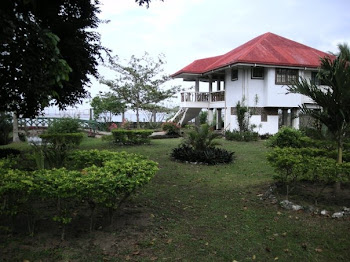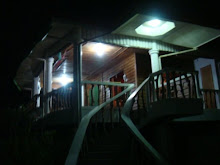It is summer time and time for family reunions. The
Nievas of the World will probably be have a reunion in the Philppines or here in US sometime this year or next year. Hopefully, Macrine and I could attend this time.

Macrine
Nieva Jambalos and husband, David Balleza Katague of Marinduque and Northern California toasting champagne during their Golden Wedding Anniversary, Boac, Marinduque, Philippines,2007
In 2003, there was a reunion of the
Nieva clan in the Philippines organized by
Rene Elizalde Nieva, Macrine's first cousin. We were invited but not able to attend. Rene wrote in his invitation that he is in the process of writing a book about the Nieva clan. He said the book will be privately published with limited printing which will include a general history starting on the possible roots of the Nieva family as well as the achievements of various members of the clan and their contribution to the betterment of Marinduque and of the Philippines. As of this writing date, I have not heard on the status of Rene's book.
In his invitation he invited all the direct and indirect descendants of the children and spouses of
Calixto Nieva and Epifania Morente. Note that Rene is the great-grandson of Calixto Nieva and Macrine is also the great-granddaughter of Calixto Nieva , thus Rene and Macrine are first cousins.
I just can not believe that my six grand children are now the
great-great-great grand children of Calixto Nieva and Epifania Morente.
Calixto and Epifania Morente had six children, four boys and two girls as follows (from oldest to youngest) along with their spouses.
1.
Juan Nieva had two wives. The first wife was
Isabel Decena. When Isabel died Juan remarried
Elvira Sarmiento. Juan Nieva is both Macrine's and Rene's grandfather. He was the
first governor of Marinduque and also the grandfather of the outgoing Governor. Rene and Macrine are first cousin of
Jose Antonio (Bong) Nieva Carrion, the outgoing Governor of Marinduque.
2.Victoria Nieva married Doroteo Mercader
3.Dionisio Nieva married Salud de la Santa
4.Gregorio Nieva married Maria Arevalo
5.Jose Nieva married Trinidad Carmona
6.Rosita Nieva married Dr Angel Mayuga
Rene's invitation also included the descendants of the brothers of Calixto, namely
Pedro and
Francisco Nieva. It also included the brothers and sisters of Epifania Morente, which included not just the
Morentes but also the
Roceses,
Abadas, Trinidads and the
Kasilags. Incidentally, the
Reyeses are second cousins of Macrine and the other Nievas of Marinduque.
This article will concentrate on the descendants of
Juan Nieva and his two wives,
Isabel Decena from Santa Cruz and
Elvira Sarmiento from Buenavista..
Children of Juan Nieva and Isabel Decena ( from Oldest to Youngest)
1.Calixto Nieva married Juanita Jambalos
2.Blanca Nieva- single was killed by the Japanese during World War II
3.
Elena Nieva married Bernardo Jambalos, Jr ( brother of Juanita)
Children of Juan Nieva and Elvira Sarmiento(from Oldest to Youngest)
1.Guillermo ( Willie) Nieva married Dr Celina Elizalde
2.Rosario Nieva married Ramon Carrion
3.Ester Nieva married Rafael Seno
4.Monica Nieva married Conrado Luarca
5.Elizabeth Nieva married Romulo Santo Domingo
6.Asuncion Nieva married Dr. Rafael Ocampo
7.Fr Constantino Nieva- single
For the purpose of this article, I will discuss only the descendants of Elena Nieva and Bernardo Jambalos, Jr. They have seven children as follows: ( From Oldest to Youngest)
1.
Macrine Nieva Jambalos- married David B Katague from Iloilo ( that's me)
2.Sister Guia Jambalos- Order of the Cenacle-single
3.Bernardo Jambalos III married Loreta Mercader
4.Fe Jambalos married Edgardo Lazarte
5.Edgar Jambalos ( deceased) married Asuncion Pagalunan
6.Jean Jambalos married Mitch Maeda
7.Rosario Jambalos married Michael Levin
Note that
Rene Nieva is the oldest son of Guillermo Nieva and Dr. Celina Elizalde. The younger brother of Rene,
Yong is my partner in our literary project, I left my Heart in Marinduque ( not San Francisco).
http://marinduqueonmymind.blogspot.com
Macrine's telephone buddy and first cousin from Vancouver, BC, Canada
Olga Luarca Quiazon is the oldest daughter of Monica and Conrado Luarca
The outgoing governor of Marinduque is the second son of Rosario Nieva and Ramon Carrion
This posting continues with the offspring of
Macrine Jambalos and David B. Katague. They have 4 children and six grandchildren as follows:
1.Dodie( Diosdado) Katague married Ruth Carver- They have 3 children, Philip Winchester, Alexandra and Marina Katague
2.Dinah E Katague married David E King- They have 2 children, Ian and Elaine King
3.David E III-single
4.Ditas Macrine Katague married Nick Thompson- They have one child, Carenna Nicole Thompson
Fe Jambalos has two daughters, Lanie and Ella
Jean Jambalos has two daughters, Yuri and Yuka
Rosario has two children, Carlos and Zehara
Asuncion and Edgar( deceased) Jambalos has three sons, Edmund, Nonoy and Jhun-Jhun and a daughter, Marilyn
Bernardo Jambalos III has five children and three grandchildren as of this writing date.
Accomplishments of the children of David B and Macrine J. Katague are discussed in detail at
http://theintellectualmigrant.blogspot.com
Some Interesting Vignettes:
The marriage of Calixto and Juanita Jambalos was not approved by their father Don Juan Nieva. Juanita was the daughter of a barrio businessman from Laylay. During those time, if you are from the barrios, you are not welcome or accepted to the social group of the main town of Boac. The Jambalos family although well off were considered TAGABUKID ( from the bonies). Don Juan Nieva wanted his lawyer son to marry Enriqueta Nepomuceno, one of the popular socialites in Boac. When Juanita died, Calixto did not marry again. Soon Calixto also died and every one in town claimed he died with a broken heart. Enriqueta in the meantime was waiting for Calixto. Enriqueta never married and died as a spinster.
Blanca Nieva graduated from Nursing School at Philippine General Hospital and was earning well. When their father died, she helped in sending her half-sister Rosario to College. She supported her sister and spoiled her by dressing her up to maintain her place in the high society of Boac at that time.
Elena, is the third child of Isabel Decena from Santa Cruz. Isabel died giving birth to Elena. Elena was therefore nursed by the sister of Isabel, Regina Decena Reforma. Elena and Policarpio Reforma ( son of Regina) shared the same breast milk of Tia Regina. When Elena was five years old, she and sister Blanca as well as brother Calixto, were brought to Boac where their father Juan Nieva remarried Elvira Sarmiento from Buenavista.
Elena grew up under the care of Lola Victoria ( sister of Juan Nieva). They lived in the old Nieva Building at the foot of the hill leading to Mataas Na Bayan. Elena later went to college at the University of the Philippines and finished her Bachelor Degree in Education.
When Juanita Jambalos-Nieva( wife of Calixto) died during childbirth, Elena and Bernardo Jambalos II ( brother of Juanita) were made in-charged of bringing the corpse from Manila back to Marinduque.
During the trip, people mistook them as husband and wife. Their romance started then and later were married at the Boac Catholic Church.
Today, if I had to guess, there should be more than seven hundred members of the Nieva clan, just based on the six children of
Calixto Nieva and Epifania Morente all over the world. If you include the descendants of
Pedro and
Francisco Nieva, the two brothers of Calixto, it could reached to more than a thousand Nievas all over the universe. If you are a member of this clan, please let me know. Someday, I may be able to trace the Nieva genealogy all the way to Spain, as I did with my mothers name
"Balleza", several years ago. My e-mail is in this site and I am also in
Face Book.
 Kulintang Ensemble from Mindanao
Kulintang Ensemble from Mindanao
 The National Commission for Culture & the Arts (NCCA), municipal government of Gasan, Gasan DepEd and Serdena organized a project to teach the art of kalutang playing to elementary and high school students in Gasan town. All recognize the importance of handing down this skill to the next generation.
The National Commission for Culture & the Arts (NCCA), municipal government of Gasan, Gasan DepEd and Serdena organized a project to teach the art of kalutang playing to elementary and high school students in Gasan town. All recognize the importance of handing down this skill to the next generation.






















